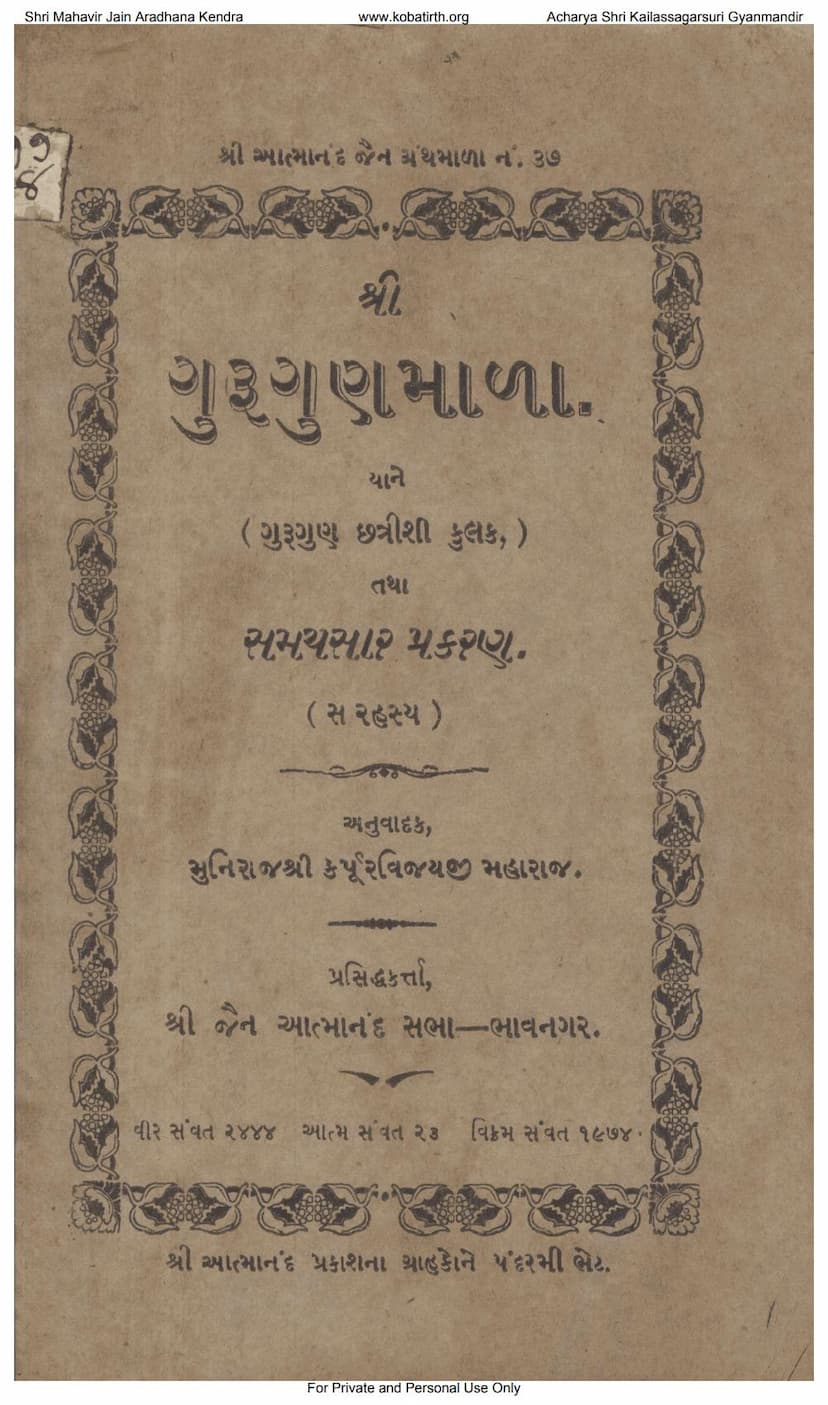Gurugunmala Yane Gurugun Chattrisi Tatha Samaysara Prakaran
Added to library: September 1, 2025

Summary
The Jain text "Gurugunmala Yane Gurugun Chattrisi Tatha Samaysara Prakaran" by Karpurvijay, published by Shri Jain Atmanand Sabha, Bhavnagar, is a compilation of two important Jain works with translations and explanations.
Key Aspects of the Text:
-
Dual Focus: The book contains two distinct sections:
- Gurugunmala (Guru-gun Trinvestri): This section focuses on the virtues and qualities of a Jain spiritual teacher (Guru). It elaborates on the thirty-six multiplied by thirty-six (36x36 = 1296) virtues attributed to an Acharya (a high-ranking spiritual leader in Jainism). The text details these qualities across various classifications and attributes, emphasizing the importance of possessing and emulating these virtues.
- Samaysara Prakaran: This section deals with fundamental Jain philosophy, particularly focusing on the path to liberation (Moksha). It highlights the significance of the three jewels: Right Faith (Samyak Darshan), Right Knowledge (Samyak Gyan), and Right Conduct (Samyak Charitra). It delves into the nature of these jewels, their interconnectedness, and their role in achieving ultimate liberation. The text also provides a brief overview of the Navatatvas (nine fundamental principles of Jainism) within the context of Samyak Darshan.
-
Author and Translator: While the original works are attributed to ancient Jain scholars, the translation and commentary in Gujarati are provided by Muni raj Shri Kapurvijayji Maharaj.
-
Publisher and Purpose: Published by Shri Jain Atmanand Sabha, Bhavnagar, the book aims to benefit the Jain community by making these profound spiritual texts accessible through clear translations and explanations. The publication is presented as a gift to the subscribers of "Shri Atmanand Prakash" magazine, highlighting the Sabha's commitment to spreading Jain knowledge.
-
Introduction and Context: The introductory sections emphasize the depth and importance of the Dravyānuyoga (the branch of Jain scriptures dealing with substances and reality). It explains that the text aims to illuminate the excellent qualities of spiritual guides and the core principles of Jainism, encouraging readers to cultivate virtues and strive for spiritual upliftment.
-
Detailed Breakdown of Gurugunmala: The "Gurugunmala" section systematically lists and describes various sets of thirty-six virtues, broken down into different categories. These categories cover aspects like:
- Four types of exposition, narration, dharma, contemplation, and remembrance.
- Ten types of samāchāri (conduct), ten types of citta samādhi (mental concentration).
- Virtues related to senses, subjects, passions, influxes, sleep, and wrong contemplations.
- Qualities related to protection of living beings, knowledge of scriptures, and behavior.
- The text details numerous specific virtues, such as knowledge of various classifications of beings, adherence to vows, conduct, ethical practices, control over passions, wisdom, devotion, and renunciation.
-
Samaysara Prakaran's Philosophical Depth: The "Samaysara Prakaran" section begins by prioritizing Moksha (liberation) among the four purusharthas (goals of human life). It explains that true and lasting happiness is attainable only through Moksha, which is achieved by the practice of Samyak Gyan, Darshan, and Charitra. The description of Navatatvas (Jiva, Ajiva, Asrava, Bandha, Samvara, Nirjara, Moksha, Pudgala, and Kala) is presented as a key element in understanding Samyak Darshan. The text then elaborates on the nature of the soul (Jiva) and non-soul (Ajiva) tattvas, detailing the various types of souls, their lifespan, physical attributes, and the influence of different stages of spiritual development (Gunasthana). It further delves into the principles of Karma, Bondage (Bandha), Cessation of Karma (Samvara), and the shedding of Karma (Nirjara) to ultimately achieve liberation (Moksha). The text also discusses the importance of Samyak Gyan, Darshan, and Charitra as the path to Moksha, emphasizing their combined efficacy.
-
Inspirational Tone: Throughout the book, there's an underlying message of devotion, reverence for spiritual guides, and encouragement for readers to cultivate virtuous qualities and pursue spiritual knowledge for their own and others' welfare. The concluding remarks express hope that by studying these texts, readers will develop virtuous qualities and attain spiritual well-being.
In essence, "Gurugunmala Yane Gurugun Chattrisi Tatha Samaysara Prakaran" is a valuable Jain scripture that serves as a guide to understanding the esteemed qualities of Jain spiritual leaders and the fundamental principles of Jainism that lead to spiritual liberation.